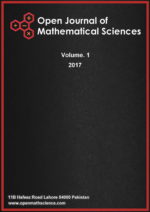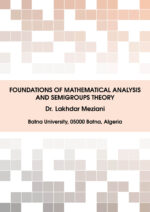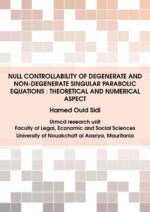Ptolemy Scientific Research Press (PSR Press)is a highly regarded publisher of scientific literature dedicated to bringing the latest research and findings to a broader audience. With a focus on cutting-edge research and technology, Ptolemy Scientific Research Press offers a range of publications catering to professionals, researchers, and student’s needs. Whether looking for information on the latest breakthroughs in physics, biology, engineering, or computer science, you can trust Ptolemy Scientific Research Press to deliver insightful, accurate, and engaging content. With its commitment to quality, accessibility, and innovation, Ptolemy Scientific Research Press is an essential resource for anyone interested in science and technology.

Latest Published Articles
OMS-Vol. 3 (2019), Issue 1, pp. 59–73 Open Access Full-Text PDF
Gbeminiyi Sobamowo, Lawrence Jayesimi, David Oke, Ahmed Yinusa, Oluwatoyin Adedibu
Abstract: This paper investigates the squeezing flow of an electrically conducting magnetohydrodynamic Casson nanofluid between two parallel plates embedded in a porous medium using differential transformation and variation of parameter methods. The accuracies of the approximate analytical methods for the small and large values of squeezing and separation numbers are investigated and established. Good agreements are established between the results of the approximate analytical methods are compared with the results numerical method using fourth-fifth order Runge-KuttaFehlberg method. However, the results of variation of parameter methods show better agreement with the results of numerical method than the results of differential transformation method. Thereafter, the developed approximate analytical solutions are used to investigate the effects of pertinent flow parameters on the squeezing phenomena of the nanofluids between the two moving parallel plates. The results established that the squeezing number and magnetic field parameters decrease as the flow velocity increases when the plates were coming together. Also, the velocity of the nanofluids further decreases as the magnetic field parameter increases when the plates move apart. However, the velocity is found to be directly proportional to the nanoparticle concentration during the squeezing flow i.e. when the plates are coming together and an inverse variation between the velocity and nanoparticle concentration is recorded when the plates are moving apart. As increased physical insights into the flow phenomena are provided, it is hope that this study will enhance the understanding the phenomena of squeezing flow in various applications such as power transmission, polymer processing and hydraulic lifts.
Review of isolation enhancement with the help of theory of characteristic modes
EASL-Vol. 2 (2019), Issue 1, pp. 12–18 Open Access Full-Text PDF
Farhan Ammar Ahmad
Abstract: Multiple-input-multiple-output (MIMO) antennas performance can be degraded due to the poor isolation between the MIMO antenna elements. In this paper, we present a review of the different isolation enhancement schemes available in the literature. Empirically the isolation between the antennas can be improved by placing the antenna as far as possible and it can be enhanced further by introducing different isolation enhancement schemes. Theory of characteristic modes (TCM) was recently proposed that has useful benefits. TCM is also used to enhance the isolation. Moreover, this papers focus on the different approaches of TCM, to enhance the isolation.
Commutators of fractional integral with variable kernel on variable exponent Herz-Morrey spaces
OMA-Vol. 3 (2019), Issue 1, pp. 19–29 Open Access Full-Text PDF
Afif Abdalmonem, Omer Abdalrhman, Hossam Eldeen Mohammed
Abstract: By using the boundedness results for the commutators of the fractional integral with variable kernel on variable Lebesgue spaces \(L^{p(\cdot)}(\mathbb{R}^{n})\), the boundedness results are established on variable exponent Herz-Morrey spaces \(M\dot{K}_{q,p(\cdot)}^{\alpha, \lambda}(\mathbb{R}^{n})\).
Bounds on the covering radius of some classes of codes over \(\mathbb R\)
ODAM-Vol. 2 (2019), Issue 1, pp. 14–23 Open Access Full-Text PDF
P. Chella Pandian
Abstract: In this paper, the covering radius of codes over \(\mathbb R ={\mathbb Z_2}{R^{*}},\) where \(R^{*}={\mathbb Z_2}+v{\mathbb Z_2},v^{2}=v\) with different weight are discussed. The block repetition codes over \(\mathbb R\) is defined and the covering radius for block repetition codes, simplex code of \(\alpha\)-type and \(\beta\)-type in \(\mathbb R\) are obtained.
The number of extended irreducible binary Goppa codes of degree \((2\ell)^m\) and length \(2^n+1\)
ODAM-Vol. 2 (2019), Issue 1, pp. 01–13 Open Access Full-Text PDF
Augustine Musukwa
Abstract: Let \(n\) and \(\ell\) be odd prime numbers such that \(\ell\neq n\) and \((\ell,2^n\pm 1)=1\). We produce an upper bound on the number of inequivalent extended irreducible binary Goppa codes of degree \((2\ell)^m\), with \(m\geq 1\) and length \(2^n+1\).
Existence and uniqueness results for Navier problems with degenerated operators
OMA-Vol. 3 (2019), Issue 1, pp. 07–18 Open Access Full-Text PDF
Albo Carlos Cavalheiro
Abstract: In this article, we prove the existence and uniqueness of solutions for the Navier problem \( \Delta\big[\omega_1(x)\vert\Delta u\vert^{p-2}\Delta u+ \nu_1(x)\vert\Delta u\vert^{q-2}\Delta u\big] -{div}\big[\omega_2(x)\vert\nabla u\vert^{p-2}\nabla u +\nu_2(x)\vert\nabla u\vert^{s-2}\nabla u\big] = f(x) – { div}(G(x)),\) in \({\Omega},\) with
\(u(x) = {\Delta}u= 0,\) in \({\partial\Omega},\) where \(\Omega\) is a bounded open set of \(\mathbb{R}^N\) for \(N\geq 2\), \(\frac{f}{\omega_2}\in L^{p’}(\Omega , {\omega}_2)\) and \(\frac{G}{{\nu}_2}\in \left[L^{s’}(\Omega ,{\nu}_2)\right]^N\).
\(u(x) = {\Delta}u= 0,\) in \({\partial\Omega},\) where \(\Omega\) is a bounded open set of \(\mathbb{R}^N\) for \(N\geq 2\), \(\frac{f}{\omega_2}\in L^{p’}(\Omega , {\omega}_2)\) and \(\frac{G}{{\nu}_2}\in \left[L^{s’}(\Omega ,{\nu}_2)\right]^N\).








